
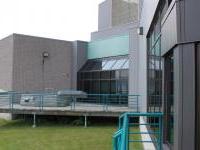 In July 1760, a decisive battle was fought on the Restigouche River estuary at the western end of the Baie des Chaleurs. That battle, called the Battle of the Restigouche, would decide the fate not just of the sailors and soldiers involved but that of New France itself. Indeed, the battle would prove to be the last engagement between English and French forces over territory in North America in the long conflict known in the history books as the Seven Years War.
In July 1760, a decisive battle was fought on the Restigouche River estuary at the western end of the Baie des Chaleurs. That battle, called the Battle of the Restigouche, would decide the fate not just of the sailors and soldiers involved but that of New France itself. Indeed, the battle would prove to be the last engagement between English and French forces over territory in North America in the long conflict known in the history books as the Seven Years War.
By the time of the Battle of the Restigouche, Quebec City had already surrendered to the English in 1759. But Montreal and New France had not. In fact, there were still large numbers of French soldiers stationed in New France, and Great Britain was far from in control of the entire colony. A French victory over the English at Sainte-Foy, near Quebec City, had forced the English to take refuge inside the city walls. In the intervening months, both sides waited for reinforcements to arrive from their respective countries.
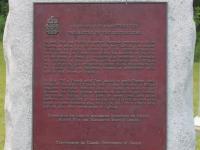 On April 10, 1760, France sent a small fleet of five merchant vessels under the escort of the French naval frigate, Le Machault, to retake and resupply Quebec. The Machault and the other five ships were heavily loaded with 2,000 casks of assorted provisions -- including everything from salt pork to wine, clothing, hardware, and arms and ammunition -- along with 400 soldiers -- both provisions and soldiers being desperately needed in New France.
On April 10, 1760, France sent a small fleet of five merchant vessels under the escort of the French naval frigate, Le Machault, to retake and resupply Quebec. The Machault and the other five ships were heavily loaded with 2,000 casks of assorted provisions -- including everything from salt pork to wine, clothing, hardware, and arms and ammunition -- along with 400 soldiers -- both provisions and soldiers being desperately needed in New France.
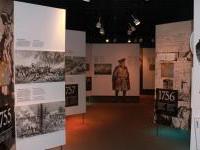 To avoid the British naval blockade, the French ships had to scatter on the open Atlantic. Only the Machault and two of the merchant ships, the Bienfaisant and the Marquis-de-Malauze, made it across the ocean. One vessel, the Fidélité, was lost in the Portuguese islands of the Azores, while two others, the Aurore and the Soleil, were intercepted by the English fleet.
To avoid the British naval blockade, the French ships had to scatter on the open Atlantic. Only the Machault and two of the merchant ships, the Bienfaisant and the Marquis-de-Malauze, made it across the ocean. One vessel, the Fidélité, was lost in the Portuguese islands of the Azores, while two others, the Aurore and the Soleil, were intercepted by the English fleet.
By the time the Machault and the two remaining merchant ships got safely across the Atlantic, rendezvousing in the Gulf of the St. Lawrence, they found that the English had arrived ahead of them and were blocking their way. The French ships were then obliged to detour to the Baie des Chaleurs. There, the local Mi'kmaq and about 1,500 Acadian refugees assisted the French ships in exchange for arms and provisions. The English, however, had quickly dispatched five of their warships in pursuit.
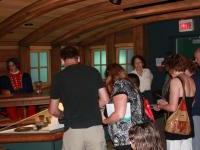 By early July, the English had arrived in the Restigouche estuary. Seeing the arrival of the English, the three French ships retreated to the western, shallower end of the bay. There they sank several small vessels as a barrier to the larger English ships, and built a small battery on the shore and supplied it with with cannons. In the engagement that ensued, the tide turned against the outnumbered and outgunned French, whose commander, Captain François Chenard de la Giraudais, decided to scuttle the Machault and the Bienfaisant on July 8, rather than see the ships and supplies fall into the hands of the English. The Marquis-de-Malauze, because it was carrying English prisoners, was spared. The French forces then retreated to the safety of the Mi'kmaq community of Listuguj on the north shore of the estuary, while the English ships headed to the fortress of Louisbourg.
By early July, the English had arrived in the Restigouche estuary. Seeing the arrival of the English, the three French ships retreated to the western, shallower end of the bay. There they sank several small vessels as a barrier to the larger English ships, and built a small battery on the shore and supplied it with with cannons. In the engagement that ensued, the tide turned against the outnumbered and outgunned French, whose commander, Captain François Chenard de la Giraudais, decided to scuttle the Machault and the Bienfaisant on July 8, rather than see the ships and supplies fall into the hands of the English. The Marquis-de-Malauze, because it was carrying English prisoners, was spared. The French forces then retreated to the safety of the Mi'kmaq community of Listuguj on the north shore of the estuary, while the English ships headed to the fortress of Louisbourg.
 When the supplies and reinforcements failed to arrive as hoped for, New France capitulated to the English in Montreal on September 8, 1760. When news of this surrender reached the Restigouche the following month, the French garrison there surrendered to the English, as well.
When the supplies and reinforcements failed to arrive as hoped for, New France capitulated to the English in Montreal on September 8, 1760. When news of this surrender reached the Restigouche the following month, the French garrison there surrendered to the English, as well.
These fascinating and influential events are commemorated at the Battle of the Restigouche National Historic Site of Canada in Pointe-à-la-Croix, Quebec. The site, run by Parks Canada, includes a museum, and overlooks the very scene of that fateful battle of two and a half centuries ago.
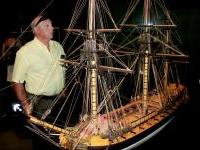 The museum, which is open to the public from early June to mid-October, includes actual artifacts that were retrieved from the wreck of the Machault which lay at the bottom of the Restigouche estuary for over two centuries. Through underwater archaeological work in the late 1960s and 1970s, hundreds of objects were brought to the surface, including several large sections of the Machault itself, an immense anchor, cannons, rifles, ship's hardware, and various other objects that were carried in the hold of the ship.
The museum, which is open to the public from early June to mid-October, includes actual artifacts that were retrieved from the wreck of the Machault which lay at the bottom of the Restigouche estuary for over two centuries. Through underwater archaeological work in the late 1960s and 1970s, hundreds of objects were brought to the surface, including several large sections of the Machault itself, an immense anchor, cannons, rifles, ship's hardware, and various other objects that were carried in the hold of the ship.
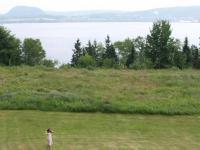 Several sections of the Machault have been skilfully recreated, including the captain's cabin, the sailors' berths, and the ship's hold. Real artifacts complement every display. Young visitors in particular will enjoy the depictions of life on the ship and will amuse themselves counting the "rats" that seem to be present just about everywhere. Bilingual interpretive panels explain the battle and its aftermath, and a deck on the outside of the museum affords a panoramic view of the estuary and of New Brunswick on the opposite side. Guided tours of the museum are available, as is an animated film about the battle.
Several sections of the Machault have been skilfully recreated, including the captain's cabin, the sailors' berths, and the ship's hold. Real artifacts complement every display. Young visitors in particular will enjoy the depictions of life on the ship and will amuse themselves counting the "rats" that seem to be present just about everywhere. Bilingual interpretive panels explain the battle and its aftermath, and a deck on the outside of the museum affords a panoramic view of the estuary and of New Brunswick on the opposite side. Guided tours of the museum are available, as is an animated film about the battle.
For more information about Battle of the Restigouche National Historic Site of Canada, call toll free 1 (888) 773-5676 or email [email protected].